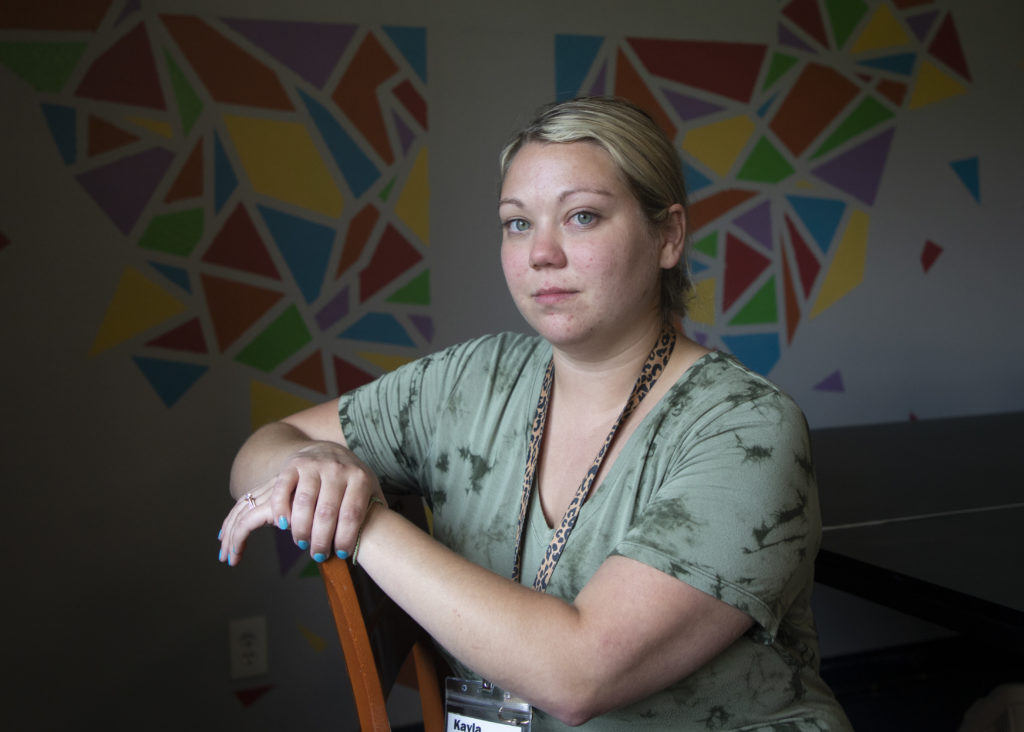Three members of first Idea Accelerator Iowa City cohort study child care workforce crisis
By Emily Kestel

If child care workers in Iowa were given a $4 per hour pay increase, what would that give them?
Breathing room. Ease of mind. A weight off their shoulders. A feeling of validation that their job is a profession.
Those were several themes that Iowa City residents Jeanie Wade-Nagle, Nancy Gardner and Lara Marsh discovered after conducting a short-term experiment through the Idea Accelerator program.
As part of the program, the three of them examined how much a $4 per hour basic pay increase to child care employees would affect attrition rates in the area.
The three women, who met each other at First Presbyterian Church in Iowa City, have seen the trickle-down effects of the child care crisis in the area firsthand.
Wade-Nagle is a retired early childhood administrator, Gardner is a retired elementary school principal, and Marsh is the owner of a small web design and hosting company. All have had children that needed child care at one point.
They all clearly saw the pain points in the industry. Parents have a hard time affording child care – or finding it altogether. Employers can’t hire employees when they’re at home taking care of their kids because they can’t afford child care. Center directors can’t retain staff because the wages are too low.
“This circular problem seemed to me like one that we should be able to fix,” Marsh said in March at the beginning of the experiment. Looking back at that time, she recently said, “Now I’m realizing how naive that statement was because it’s such a huge problem.”
The problem
Iowa City is not immune to the barriers of affordability and availability that plague the inner workings of the child care industry across the state and country.
Johnson County has some of the most expensive child care rates in the state. Last year, the average cost to send a toddler to a child care provider was between $162 and $250 per week – or roughly $8,500 to $13,000 per year. There are more than 200 child care programs and 9,000 spaces listed with Iowa Child Care Resource and Referral in the county, but when you look at the total number of kids between the ages of zero and 5, there’s a shortage of more than 1,000 slots.
Beyond the raw numbers, though, are the strict staff-to-children ratio requirements that determine the capacity of each provider. A center may have capacity for 200 kids, but if there are not enough staff members to meet the ratio requirements, many of the kids will be turned away.
Last year, child care providers sounded the alarm about workforce shortages, saying it had never been this bad before. Child care workers across the country were leaving the industry in droves for higher-paying positions elsewhere, leaving large gaps in the availability of slots.
Read more about the child care workforce crisis in the state
A child care worker in Iowa earning the median hourly wage of $13.85 is barely making the wage needed to cover basic living expenses. To afford basic needs for survival – housing, food, utilities, clothes, health care and transportation – an Iowa worker must make close to $14 per hour, according to Common Good Iowa. If that worker is a single parent with one child, that wage goes up to more than $21.
But unless they receive outside funding, the only way child care directors can raise wages for their staff is by increasing tuition costs, which further burdens the parents already paying an average of 12% of their income on child care – or 40% if they’re a single parent. In some multi-parent families, they find it makes more sense to have one parent drop out of the workforce entirely to stay at home and take on a caregiving role, which can then lead to an overall community workforce shortage.
It’s an endless cycle that doesn’t have one magic bullet solution. However, caregiving advocates and leaders in the child care industry have said providing direct payments to child care workers would be a good place to start.
Since the release of recommendations by Gov. Kim Reynolds’ Child Care Task Force last year, the state of Iowa has allocated more than $500 million in state and federal funds to address the child care crisis, including $200 million from the American Rescue Plan earmarked for stabilization grants, which can be used for personnel costs.
The idea
Wade-Nagle expressed frustration about the pace of progress on addressing the child care crisis. While she acknowledged that many groups have been working on the issue of child care for years, she said something different needed to be done.
“Jeanie uses the phrase, ‘Everybody has been admiring the problem’ and not really looking at, OK, how are we going to address it? What are we going to do?” Gardner said.
“We need to do something that can show a change faster. Some of the solutions that the Legislature is coming up with aren’t satisfactory to me,” Wade-Nagle said. “Putting more kids together and putting them with younger kids … is not the solution, from my vantage point.”
Marsh encouraged the three of them to apply to the Idea Accelerator program to explore their ideas.
The 90-day program is a partnership with the Iowa City Area Development Group, Heartland Forward, and Builders and Backers that’s focused on finding creative solutions to community problems. Members of the cohort were each given $5,000 to conduct their experiments, which ranged from developing a new model for healthy living, increasing collaboration for women in the tech industry, finding ways to learn how to read music faster, and increasing teens’ sense of belonging. The first cohort concluded in May.
Wade-Nagle, Gardner and Marsh chose to focus their efforts on looking at factors into what pushes child care workers out of the industry, particularly around the idea of wages. After talking with several “builders in residence” within the program, they decided to put their $5,000 to use by giving it directly to child care workers through $4 per hour pay increases.
They called around to several child care providers in the area before landing on one that was the right size – small enough to make a sizable impact for all full-time employee wages, but big enough to examine potential themes. They landed on Loving Arms Kids Care, a center on the eastern side of Iowa City.

The experiment
Kayla Jordan is the director of Loving Arms Kids Care. The center has capacity for 121 kids from birth to age 12, but with a staff of eight full-time and 15 part-time employees, she’s sitting at about 70 kids. If she could hire and retain a consistent number of staff members, she could accept more kids.
But the staff turnover is constant, she said. “Why would you work here where you’re responsible for human lives, making $11 an hour, when you can go work at a restaurant and start at $15 an hour?”
Starting wages prior to the experiment were between $10.75 and $14 for full-time teachers at Loving Arms Kids Care, which is below the wage needed to afford basic living expenses in the current economy.
When Jordan was approached by Wade-Nagle, Marsh and Gardner about their experiment that would involve giving their full-time staff a $4 per hour pay increase for four weeks, no strings attached, she was initially leery.
“At first I thought it was too good to be true,” she said. “Child care workers don’t get a lot of support.”
When Jordan asked why they were doing this, Gardner said, “We’re just people that care a lot about why we’re not retaining staff and why we’re not paying them what they need.”
After getting approval from the Loving Arms Kids Care board, Wade-Nagle, Marsh and Gardner conducted a brief anonymous survey of the eight staff members, including Jordan, before they knew they would receive a temporary pay increase.
In addition to demographic questions, they asked the child care staff members their family’s financial situation, how long they’ve worked at the center, how long they envisioned themselves working there, what factors would make them seek a position elsewhere, how satisfied they were with their wages and what they would spend an extra $4 an hour on.
After completing the survey, Wade-Nagle, Marsh and Gardner worked with Jordan to disperse prepaid Visa gift cards loaded with the $4 per hour pay increase along with their regular paychecks every two weeks for a month. They also conducted a post-experiment survey with the same questions.
The results
Elise, who declined to share her last name, has worked in the field of child care for more than 20 years at various child care centers. She was making $13.50 an hour when she began working at Loving Arms Kids Care in February.
She takes care of her parents, and said her earnings are stretched pretty far. “There are weeks where I’m right at the bottom of my bank account,” she said.
Elise said the $4 per hour experimental increase was “amazing.” She didn’t put it toward bills because doing so would create more hassle with temporarily changing forms of payment for autopay accounts, she said. Instead, she spent it on things like a new pair of jeans, better paper towels, and food brands she wouldn’t normally be able to buy.
“I was able to buy name-brand toilet paper that I can’t see my hand through,” she said.
“I was able to buy name-brand toilet paper that I can’t see my hand through.”
ELISE, a child care worker at loving arms kids care
“I was able to go to the grocery store and not pinch pennies,” Jordan added. “Those little things really matter and build up in your life.”
“People talk a lot about ‘Somebody ought to do something,’ ” Wade-Nagle said after the experiment had concluded. “It felt really good to be able to be somebody and that the three of us could make a difference for a few for a short time.”
Elise said child care workers just want to be paid enough to where they’re thriving instead of just surviving. “We have to be able to pay our bills and have enough left over to continue living outside of work.”
Jordan said it breaks her heart knowing that as the person signing their checks, she can’t give her staff what they deserve.
“We deserve a livable wage,” Jordan said. “Some of the people that work here live in poverty, they get food stamps. This is supposed to be a career. It’s sad that they have to save up for a pair of pants.”
The data
- For all eight of those participating in the experiment, either they were the sole provider for their family or their income was necessary for their livelihood.
- Before the experiment, 75% of those who took the survey said they saw themselves being employed at Loving Arms Kids Care for one year or less from that point. When asked in the post-experiment survey how long they saw themselves being employed there if the experimental pay continued beyond the trial period, 75% said three years or more from that point.
- Higher wages was consistently the No. 1 factor for seeking a position elsewhere in both the pre-experiment and post-experiment surveys. Other factors mentioned were better hours, better benefits and more professional development.
- Before the experiment, 62.5% of those who participated said the No. 1 area they’d spend the extra $4 per hour on would be their rent or mortgage. After the experiment concluded, 37.5% said rent or mortgage was the No. 1 area they spent the extra money on.
In a series of open-ended questions posed in the post-experiment survey, Wade-Nagle, Gardner and Marsh asked how the experiment affected participants emotionally and professionally, and how it affected their level of pride in the job and their family’s well-being. Below are selected responses, which have been lightly edited for clarity.
- How the experiment affected you emotionally
- I was able to feel much more relaxed knowing that finances wouldn’t be a burden for at least one month.
- I was happy I didn’t have to decide between food or water bill.
- I wasn’t as stressed trying to figure out how to pay some bills and get food on the table for my family.
- How the experiment affected you professionally
- I felt like my job was more important. I finally felt like the child care profession was just that, a profession and not a babysitting service.
- As child care is a generally underpaid field, it was enjoyable to see that the wages represented the job responsibilities at a livable rate.
- I had less on my mind, which weighed me down less at work.
- Made me want to show up for work.
- How the experiment affected your pride in your job
- This experiment made me want to do better for myself, my co-workers, families, and most importantly, the children.
- The higher wages allowed me to appreciate my position and feel validated financially as this can be a thankless job.
- I’m proud of what I do, I think I work hard and deserve to be paid well for that work.
- It did not affect pride in my job, my pride in my job is not affected by how much I am paid.
- Made me appreciate my job so much more.
- How the experiment affected your family’s well-being
- This had a huge impact on my family’s well-being. I was able to provide nutritious meals and medication for myself and my daughter without having to dip into my hard-earned savings.
- This experiment relieved a lot of fear and anxiety surrounding the inevitable costs of groceries, bills and transportation, which allowed more opportunity to purchase things that bring me and my household joy.
- Me, my husband and kids were happier.
Takeaways
Marsh said she was initially surprised that many of them didn’t necessarily feel more valued with more money. Then she turned to Maslow’s hierarchy of needs for context.
“They’re in survival mode in a lot of ways. They’re not looking to feel validated, they’re looking to just buy food for their children,” she said. “They don’t have the luxury of feeling great about their job, they’re just trying to put food on the table.”
Another key takeaway was that by increasing their wage, more child care workers said they’d likely stay at their place of employment longer.
“That’s huge because of the cost of hiring new employees, training and background checks,” Marsh said. “If you can keep most of your staff for three years or more, you’re going to save a ton of money.”
Progress
A few months after the experiment was completed, Jordan said she was able to offer pay raises to the teachers after receiving $60,000 from the state’s child care stabilization grant. Instead of offering starting wages at $10.75 per hour, now she can pay “anywhere from $12 to $17 per hour” depending on experience.
Already, she’s seen an increase in interest.
“I couldn’t get anyone through the door with the wages we were offering before,” Jordan said. “I had an ad out for two months with no bite. When we came out with the new scale, I put a new ad out and got 10 resumes within the first two weeks.”
The future
Wade-Nagle, Gardner and Marsh recognize this was a hyper-local example and not a long-term solution, but they hope the data and experiences they collected will be useful to help inform decision-makers in the areas of business, state government and philanthropy of what better pay does to affect retention.
“By having the hard data … hopefully we can open the eyes of people that have the ability to make a difference,” Gardner said.
The three of them said they’d like to see a steady stream of state and federal funds go directly toward funding child care operations.
“The money’s there. Didn’t we have a surplus in the state budget?” Gardner said. “I know we need money for different things in the state, but this is a priority.”
“The money’s there. Didn’t we have a surplus in the state budget? I know we need money for different things in the state, but this is a priority.”
Nancy Gardner


1 Comment
Maeleen Thorius · August 19, 2022 at 7:33 pm
Congratulations to all three of you for getting hard data! I noticed you had 8 participants. Did anyone leave in the middle of the month or “experiment”? It seemed not all answered the questions. I wonder about a “post” questionnaire…after the month of a $4 increase and then it is gone. Wonder what that did with attrition? This is a critical need. I hope you send your work on to state legislators and the governor.
I also wonder about the education levels of these caregivers. I am thinking of possible grants training, etc. This article should also go to the Press Citizen! Or the Gazette! Great job, ladies!
Comments are closed.